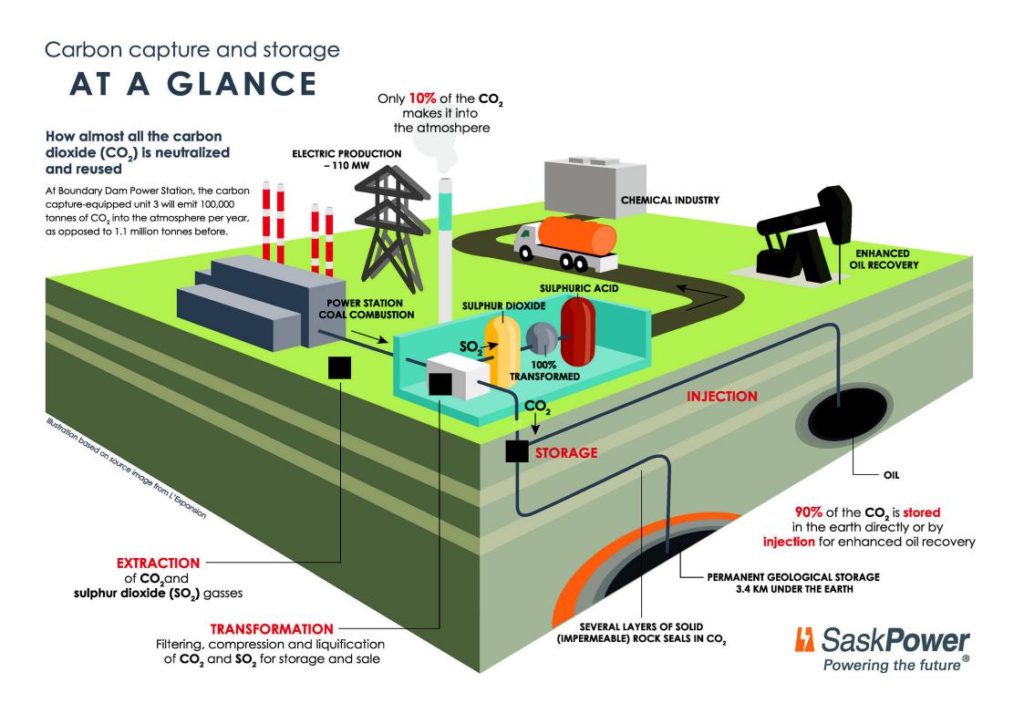Carbon Capture and Storage, the fossil fuel industry’s last gasp for breath
Part 1
Carbon Capture and Storage (CCS) is being promoted by some prominent politicians, business and lobby groups, and even scientists. In fact the latest Intergovernmental Panel on Climate Change (IPCC) assessment report has indicated that CCS will be needed as part of the international arsenal for mitigating climate change; or, at-least, keeping warming below 2 degrees. However when looking at the different organizations and people promoting it, CCS looks increasingly like a last ditch attempt by the fossil fuel industry to excuse its continued exploration for fossil fuels. This technology is real but it is very expensive, carbon leaks are almost inevitable, and it is unlikely to be ready in time. A lot of promotion is going into a technology which simply protects the status quo of fossil fuel exploration and distracts from a push for social change and sustainable development.
What the hell is Carbon Capture and Storage?
Unlike natural ways of storing carbon, which are often referred to as carbon sinks (trees, ice, oceans etc), CCS involves using technology to capture the carbon emitted from power plants, transporting it via trucks or pipelines, and then storing it in large reservoirs such as natural caves or what used to be oil and gas wells. It is not as simple as fitting pipes to the top of smoke stacks because Carbon Dioxide has a tendency to pool in areas and so needs to be treated, often through a form of liquidation and compression, before it can be transported. This takes a large amount of energy to do, significantly decreasing the efficiency of the power plant. The technology is in its infancy and also incredibly expensive. There are several projects in development around the world however with no real price on carbon the only way these experimental CCS power plants can fund themselves is through a strangely self-defeating method of selling the carbon dioxide captured to oil companies which then use it to increase their oil production.

An example of this absurdity is the recently opened Canadian Boundary Dam Coal Power plant. This is the first large power plant to be built with CCS and has been lauded by the International Energy Association (IEA) as “historic” (IEA, 2014). This project cost $1.3 billion and produces a mere 110 MW (IEA, 2014). To put this in perspective the Huntly power station in Aotearoa produces over 1000 MW. This new power plant then sells the carbon it produces to a state owned oil company which uses this to increase production in nearby oil fields.
Why CCS is not a real solution to climate change
As has already been mentioned, CCS is a very expensive technology and vastly decreases the efficiency of electricity generation through the process of capture, transporting, and storing carbon. However it is also unlikely to arrive in time, distracts from actual change, and contains significant risks such as carbon leaks.In addition, CCS allows fossil fuel exploration and the building of power plants to continue, locking in further emissions.
CCS technology will not arrive soon enough to be a significant help in reducing emissions. The United Nations Development Program (UNDP) has said, “CCS will arrive on the battlefield far too late to help the world avoid dangerous climate change” (Greenpeace, 2008). The World Business Council for Sustainable Development (WBCSD), which represents well known big businesses from Coke to Shell, estimates that CCS will not be “technically feasible at utility level” until the 2030s (WBCSD, 2006). Since the WBCSD is now advocating for the use of CCS we can probably assume these estimates are a bit generous. With IPCC estimates of a 50-80% reduction in emissions from 1990 levels by 2050, in-order to avoid catastrophic climate change, we already need to be on a significant downward trend by the time CCS is ready for large-scale use. As such it is no holy grail which can magically solve the problem. Even advocates such as the WBCSD are suggesting that CCS would only be a small part of a much larger package of ways to reduce emissions.
There are also significant threats of leaks. A report by Greenpeace in 2008, False Hope, says that even a leak as small as 1% from any carbon storage reservoir would defeat the purpose of CCS when one considers the huge amount which would be stored were it to be pursued on a large scale. Unfortunately a Queens Policy review article states that “the Intergovernmental Panel on Climate change predicts with 90 to 99 percent certainty that well-designed reservoirs will hold 99 per cent of CO2 injected for 100 years” (Burgess, C. 2011). As such, leaks of some form are almost certain. In fact leaks from such projects have already happened. For example, in 2011 in Saskatchewan carbon dioxide leaked from Cenovus’s CCS project. This short term focus is also glaringly obvious as in-order to effectively avoid climate change reservoirs must continue to store carbon indefinitely, not just for 100 years. However, there are much larger threats from carbon leaks. This is because carbon dioxide, as already stated, tends to pool in areas and concentrations of more than 3% are hazardous to human health (Greenpeace, 2008). A disturbing example of the deadly effects of CO2 was the 1986 Lake Nyos disaster in which 1,700 people were killed by a naturally formed CO2 cloud. This threat of leaks would perhaps explain why companies pursuing CCS are seeking to move the long-term liability for leaks to Governments (Burgess, C. 2011).
As such, this technology could create new environmental threats which businesses will not be held to account for, while also not addressing climate change.
The promotion of CCS acts to maintain the status quo rather than promote meaningful change. This is because, rather than promoting sustainable development fossil fuel power plants are simply being promoted as Carbon Capture ready. However, this notion of “carbon capture ready” is so broad as to render it meaningless. The IEA defines carbon capture ready as any power plant “which can be retrofitted with CO2 capture when the necessary regulatory or economic drivers are in place” (IEA). This effectively allows for a re-branding exercise rather actually taking action to reduce emissions.
This has been pushed for by Governments such as the United Kingdom’s Conservative Government. Prior to an announcement in 2014 all new fossil fuel power plants over 300 MW were to be built “carbon capture ready”. However at the climate change conference of 2014 Cameron announced a new policy that all new coal power plants would be built with CCS and announced a £1 billion investment in CCS (gov.uk). Keep in mind that the 100 MW power plant in Canada cost $1.3 billion and that the UK has been implementing tight austerity policies since the Conservatives came to power. This money could have gone to a sector benefiting those on vulnerable low incomes rather than to a life line for the fossil fuel industry. The UK is a good example of regressive action on climate change where initiatives such as CCS and nuclear power are receiving significant investment potentially at the expense of those most vulnerable. For example the £350 million cuts to legal aid, and the spare bedroom tax costing 660,000 people in state housing up to £726 per year (The Guardian, 2013).
While Oil Free Wellington is not arguing for vague concepts such as “green jobs” and “clean tech”, with estimates that jobs in renewable energy produce ten times as many jobs as the fossil fuel industry there is already one clear way of beginning to address climate change and poverty. While investment in renewable technology will not completely address social and economic inequality it does show that environmental and social concerns can be addressed at the same time. They do not need to be addressed at the expense of the other.
